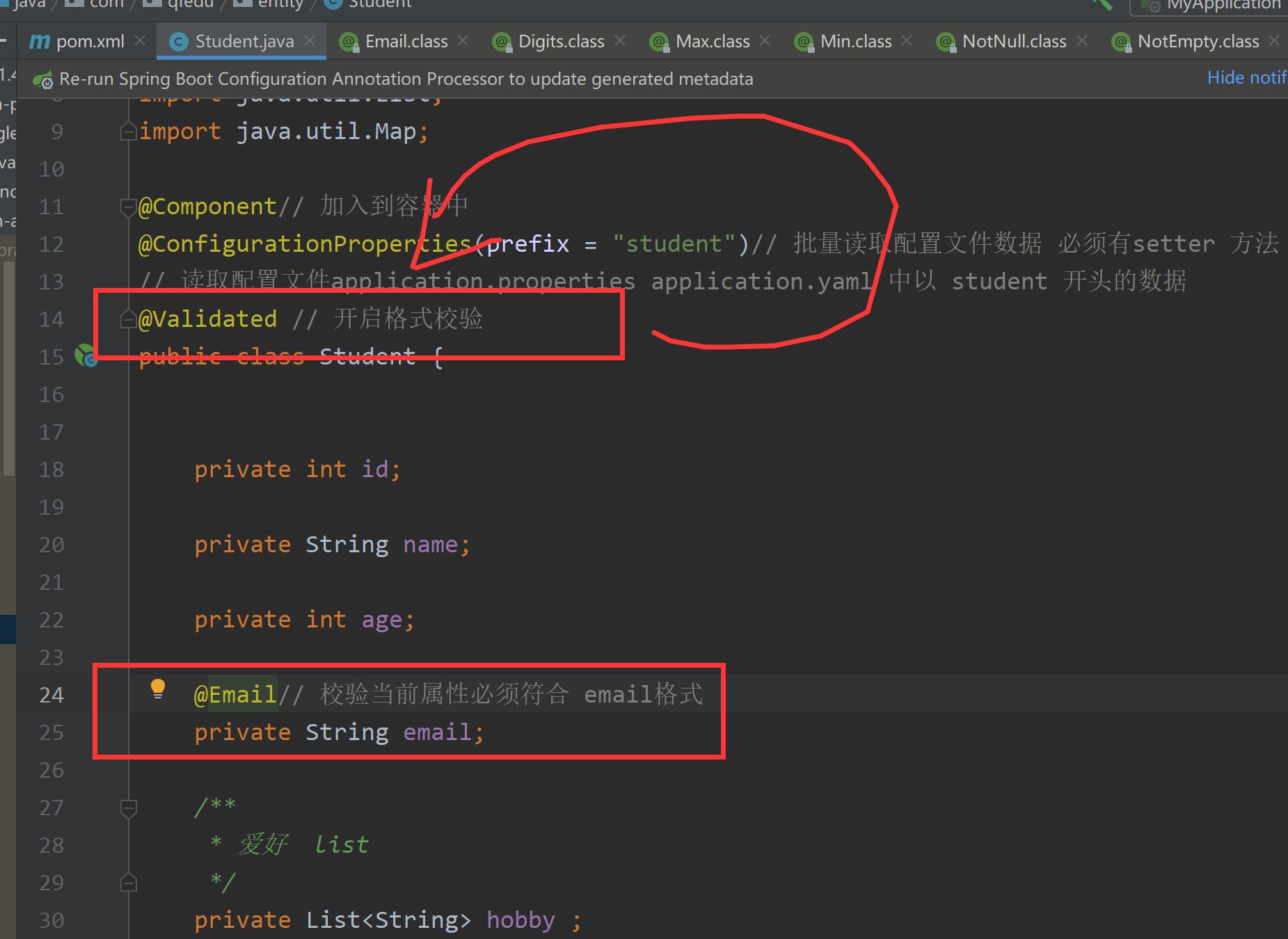Springboot
Posted xue_yun_xiang
tags:
篇首语:本文由小常识网(cha138.com)小编为大家整理,主要介绍了Springboot相关的知识,希望对你有一定的参考价值。
一、概述
Spring Boot是基于Spring框架开发的全新框架,其设计目的是简化新Spring应用的初始化搭建和开发过程。
Spring Boot 只是 对springFramework 框架封装, 简化了开发(spring 整合 spring mvc ,mybatis 还有其他第三方的插件)
Spring Boot整合了许多框架和第三方库配置,几乎可以达到“开箱即用”。
开箱即用:几乎0配置,可以不做任何的配置,只需引入依赖,就可以使用
约定优于配置:Spring Boot配置很多默认规则,不需要bean.xml 进行配置,装配
消灭了 bean.xml
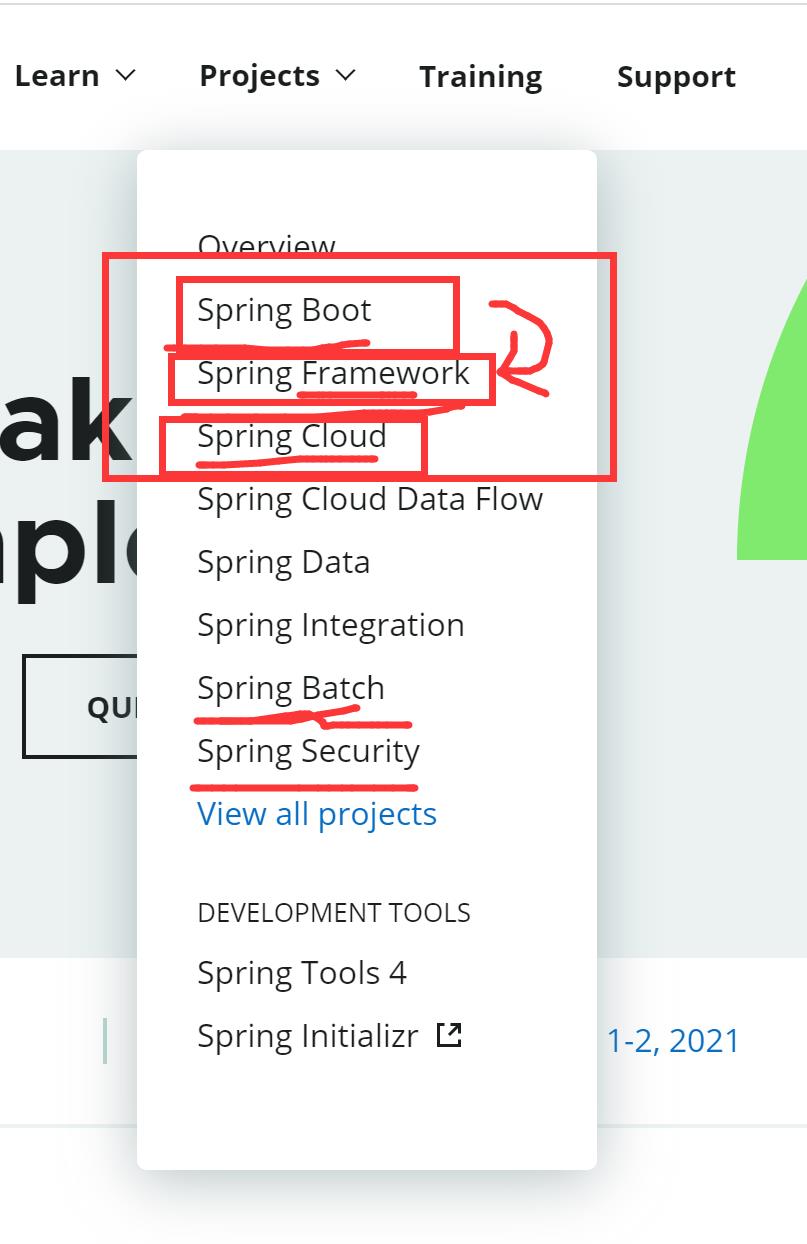
优点:
- 可快速构建独立的Spring应用
- 直接嵌入Tomcat、Jetty和Undertow服务器(无需部署WAR文件)
- 提供依赖启动器简化构建配置- 极大程度的自动化配置Spring和第三方库
- 提供生产就绪功能
- 极少的代码生成和XML配置
二、Springboot和SpringMVC区别
Spring 框架就像一个家族,有众多衍生产品例如 boot、security、jpa等等。但他们的基础都是Spring 的ioc和 aop,ioc 提供了依赖注入的容器, aop解决了面向横切面的编程,然后在此两者的基础上实现了其他延伸产品的高级功能。
Spring MVC提供了一种轻度耦合的方式来开发web应用。它是Spring的一个模块,是一个web框架。通过Dispatcher Servlet, ModelAndView 和 View Resolver,开发web应用变得很容易。解决的问题领域是网站应用程序或者服务开发——URL路由、Session、模板引擎、静态Web资源等等。
Spring Boot实现了自动配置,降低了项目搭建的复杂度。它主要是为了解决使用Spring框架需要进行大量的配置太麻烦的问题,所以它并不是用来替代Spring的解决方案,而是和Spring框架紧密结合用于提升Spring开发者体验的工具。同时它集成了大量常用的第三方库配置(例如Jackson, JDBC, Mongo, Redis, Mail等等),Spring Boot应用中这些第三方库几乎可以零配置的开箱即用(out-of-the-box)。
Spring Boot只是承载者,辅助你简化项目搭建过程的。如果承载的是WEB项目,使用Spring MVC作为MVC框架,那么工作流程和你上面描述的是完全一样的,因为这部分工作是Spring MVC做的而不是Spring Boot。
对使用者来说,换用Spring Boot以后,项目初始化方法变了,配置文件变了,另外就是不需要单独安装Tomcat这类容器服务器了,maven打出jar包直接跑起来就是个网站,但你最核心的业务逻辑实现与业务流程实现没有任何变化。
三、springboot 搭建
1、创建java maven 功能
<!--引入父依赖
当前工程 继承 父类工程 spring-boot-starter-parent pom
-->
<parent>
<groupId>org.springframework.boot</groupId>
<artifactId>spring-boot-starter-parent</artifactId>
<version>2.1.3.RELEASE</version>
<relativePath/>
</parent>
<dependencies>
<!-- web相关依赖-->
<dependency>
<groupId>org.springframework.boot</groupId>
<artifactId>spring-boot-starter-web</artifactId>
</dependency>
<dependency>
<groupId>org.springframework.boot</groupId>
<artifactId>spring-boot-starter-test</artifactId>
</dependency>
</dependencies>
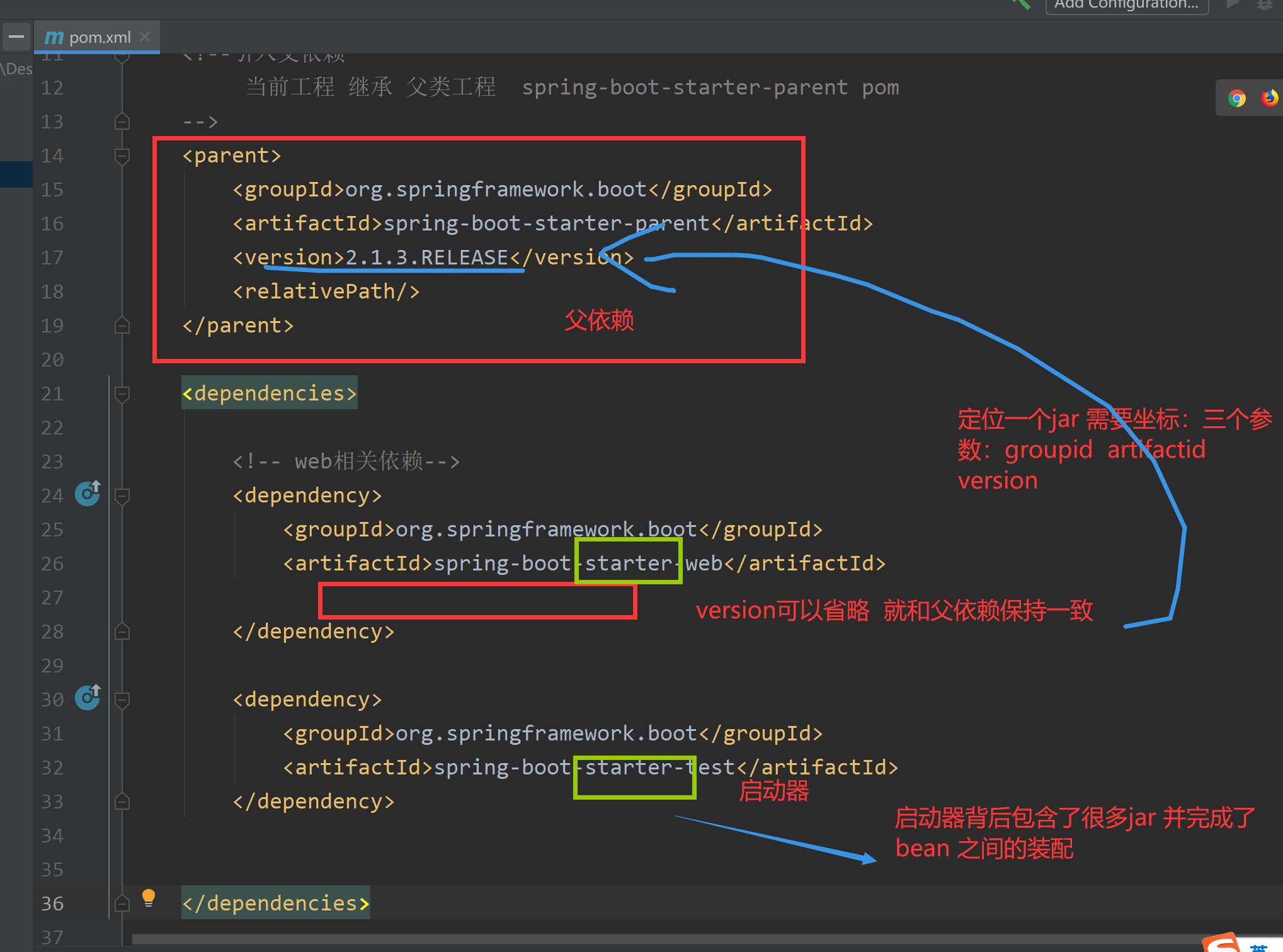
2、创建启动类
import org.springframework.boot.SpringApplication;
import org.springframework.boot.autoconfigure.SpringBootApplication;
//标记当前类是当前应用的启动类 只有一个
// *******重点:当前类只能在项目中的根目录 不能放在其他目录(controller,service)中
@SpringBootApplication// 完成了springboot 自动装配
public class MyApplication {
public static void main(String[] args) {
// 启动springboot 应用
SpringApplication.run(MyApplication.class,args);
}
}
3、创建控制器
/**
* 第一个springboot 控制类
*/
@RestController// 等价于 @Controller +@ResponseBody
public class HelloController {
@RequestMapping("/test1")
public String test1(){
return "hello word";
}
}
4、启动
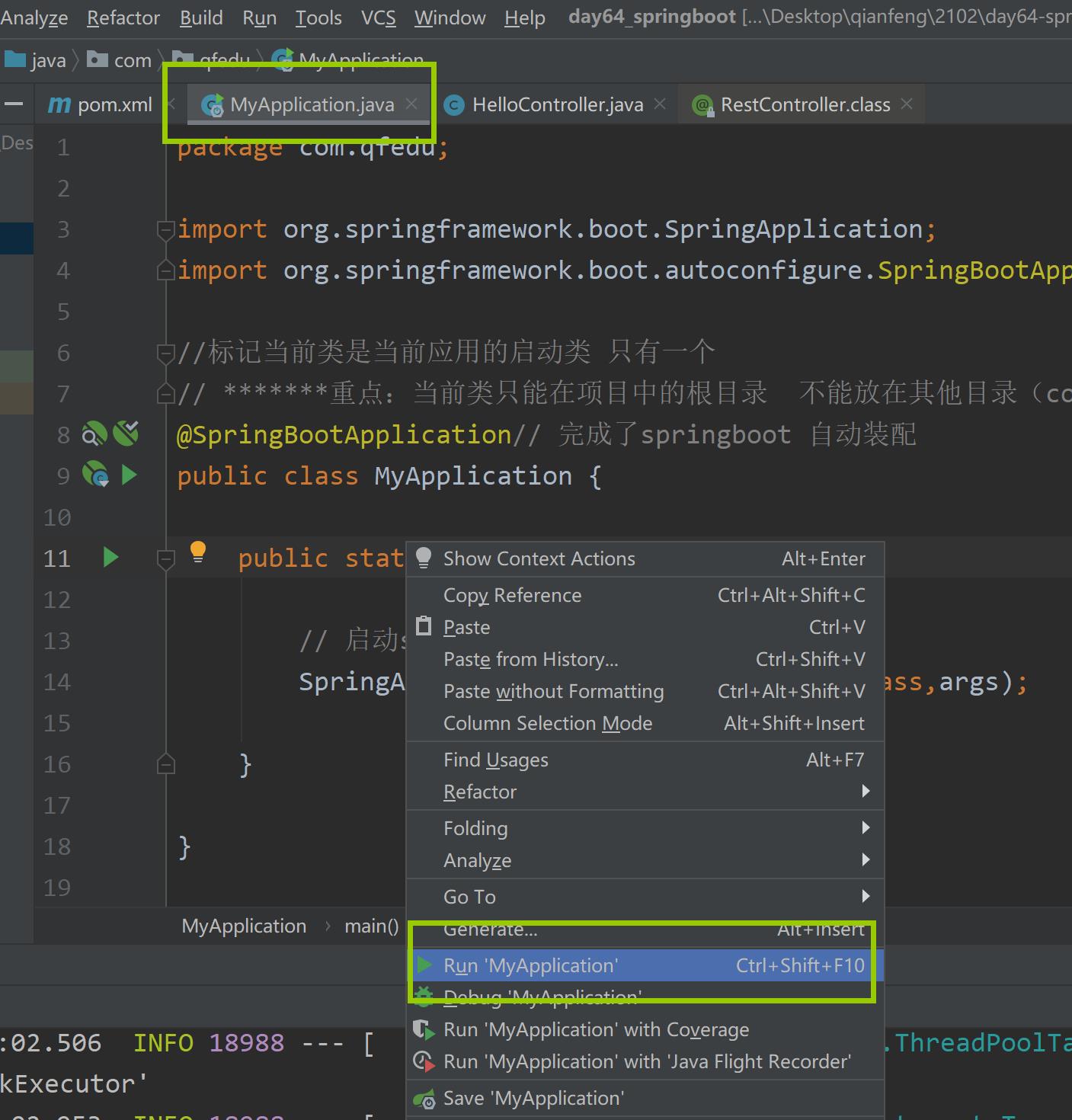

5、测试
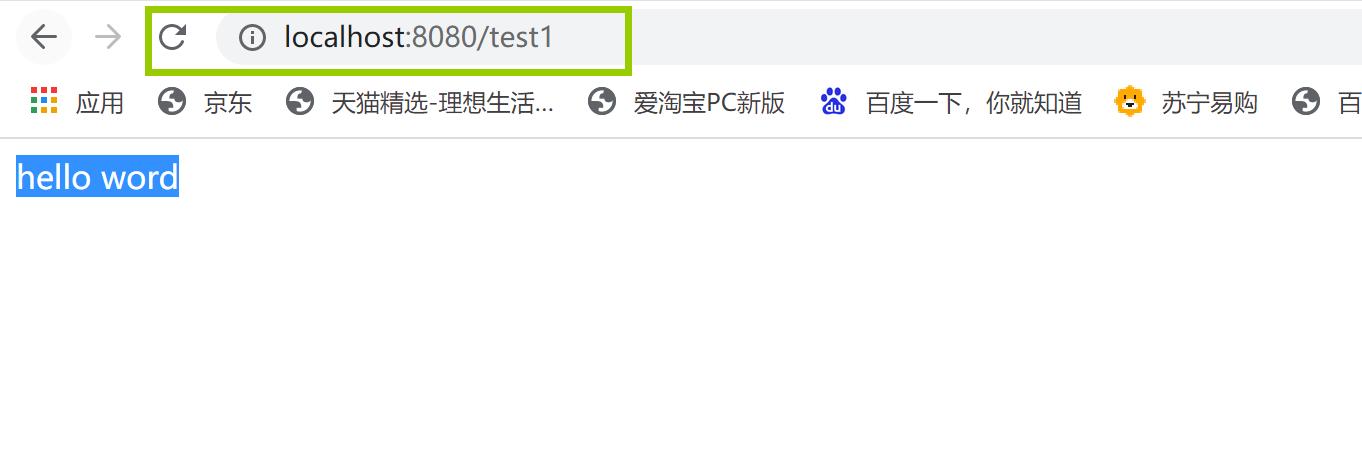
四、springboot 配置文件
1、在resources 下创建 application.properties (名字一定不要错)
# 注释
# 配置tomcat 端口号
server.port=8088
2、springboot 配置文件 在 resources:
- application.properties
server.port=8088
# key=value
- application.yaml application.yml
yaml 文件也是一种配置文件,功能和application.properties一样,更加简洁(超json 格式)
application.properties 文件优先级高于application.yaml
application.properties
# 注释
# 配置tomcat 端口号
#server.port=8088
student.id=100
student.name=xiaoming
student.age=19
#配置 集合属性 属性之间以 ,分割
student.hobby=pingpang,basketball,football
#配置 map 属性
student.course.math=99
student.course.english=100
application.yml / application.yaml
什么是ymal?
- YAML文件格式是Spring Boot支持的一种JSON超集文件格式。
- 相较于传统的Properties配置文件,YAML文件以数据为核心,是一种更为直观且容易被电脑识别的数据序列化格式。
- application.yaml文件的工作原理和application.properties一样。
基本语法:key:(空格)value

server:
port: 8090
# 等价于 application.properties 中 student.id
student:
id: 100
name: xiaoming
age: 18
# # 使用 yaml 另一种方式配置 集合 map
hobby:
- pingpang
- basketball
- football
course:
math: 99
english: 100
email: xiaoming163.com
# 使用 yaml 配置 集合 map
# hobby: [pingpang,basketball,football]
# course: {math: 99,english: 100}
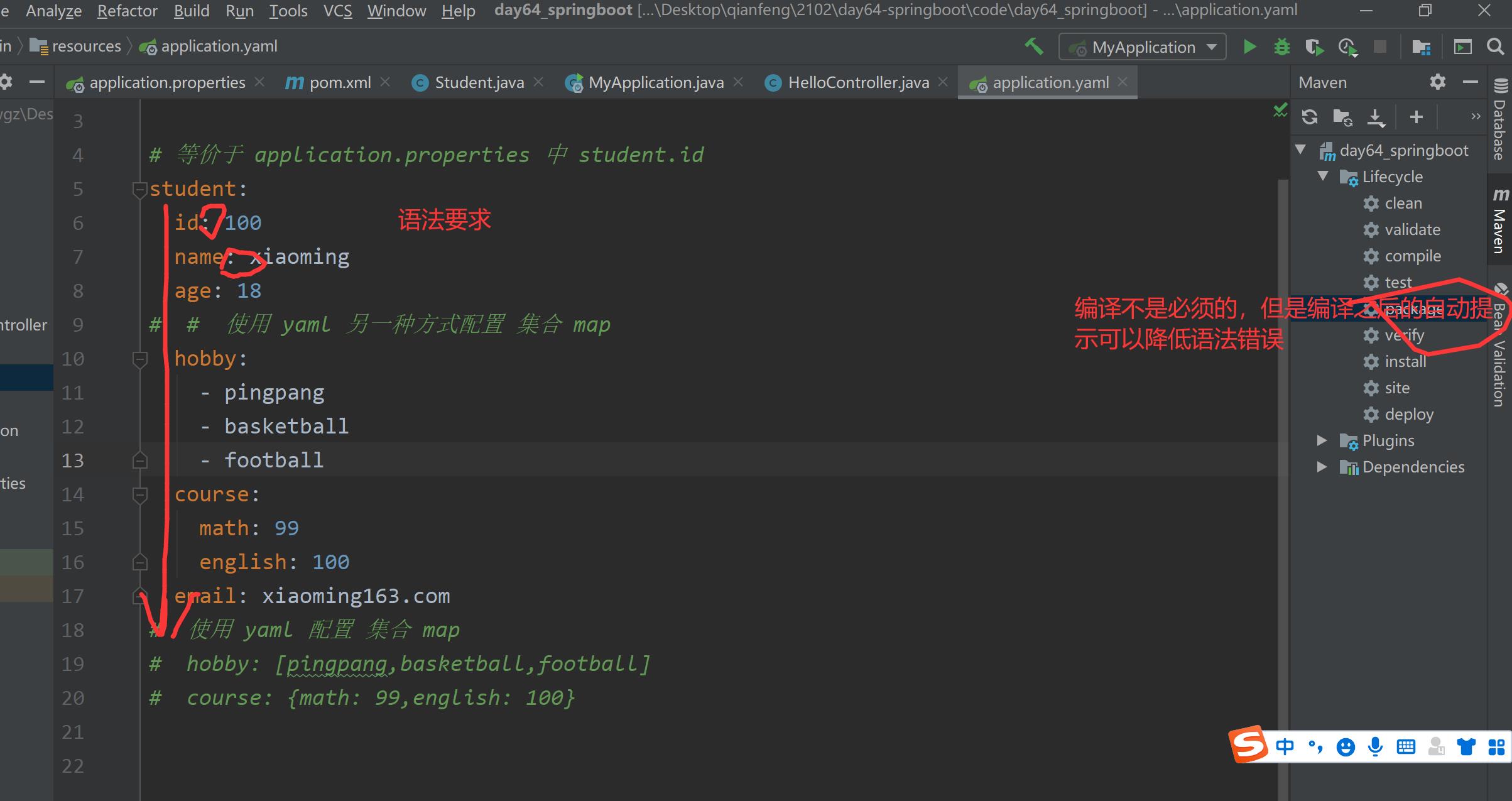
3、自动提示
第一步、添加依赖
<!-- Spring Boot提供的配置处理器依赖
作用就是:让自定义属性配置 在编写配置文件时有提示:
必须先编译才会有提示
-->
<dependency>
<groupId>org.springframework.boot</groupId>
<artifactId>spring-boot-configuration-processor</artifactId>
<optional>true</optional>
</dependency>
第二步、编译
mvn compile # 或者 点击按钮 compile
4、格式校验
在类上校验@Validated
在属性添加 @Email @Max……
5、批量读取自定义配置文件
mybatis.properties
jdbc.driver=com.mysql.jdbc.Driver
jdbc.url=jdbc:mysql://localhost:3306/qfofficejava2102
jdbc.name=root
jdbc.password=123456
@Component
@ConfigurationProperties(prefix = "jdbc")//只能读取 application.properties application.yaml
@PropertySource(value = "mybatis.properties") //如果读取自定义配置文件 必须使用 @PropertySource(value = "mybatis.properties") 制定路径
public class JdbcProperties {
private String driver;
private String url;
private String name;
private String password;
public String getDriver() {
return driver;
}
public void setDriver(String driver) {
this.driver = driver;
}
public String getUrl() {
return url;
}
public void setUrl(String url) {
this.url = url;
}
public String getName() {
return name;
}
public void setName(String name) {
this.name = name;
}
public String getPassword() {
return password;
}
public void setPassword(String password) {
this.password = password;
}
}
6、@Value单个读取属性
/**
* 测试 @Value单个读取属性
*
* 总结 1.@Value("${student.id}") 单个读取 配置文件application.yaml
* 2.不支持复杂数据类型 集合 map
* 3.@Value 不需要set 方法支持
*
*/
@Component
public class Student2 implements Serializable {
@Value("${student.id}")
private int id;
@Value("${student.name}")
private String name;
@Value("${student.age}")
private int age;
@Value("${student.email}")
private String email;
/**
* 爱好 list
*/
// @Value("${student.hobby}") @Value 不支持 集合读取
private List<String> hobby ;
/**
* 科目对应成绩 map
*/
// @Value("${student.course}") @Value 不支持 map读取
private Map<String,Integer> course;
public int getId() {
return id;
}
// public void setId(int id) {
// this.id = id;
// }
public String getName() {
return name;
}
// public void setName(String name) {
// this.name = name;
// }
public int getAge() {
return age;
}
// public void setAge(int age) {
// this.age = age;
// }
public String getEmail() {
return email;
}
public void setEmail(String email) {
this.email = email;
}
public List<String> getHobby() {
return hobby;
}
public void setHobby(List<String> hobby) {
this.hobby = hobby;
}
public Map<String, Integer> getCourse() {
return course;
}
public void setCourse(Map<String, Integer> course) {
this.course = course;
}
@Override
public String toString() {
return "Student2{" +
"id=" + id +
", name='" + name + '\\'' +
", age=" + age +
", email='" + email + '\\'' +
", hobby=" + hobby +
", course=" + course +
'}';
}
}
五、总结
@ConfigurationProperties 是批量读取配置文件
@ConfigurationProperties和@Value的对比
| 对比点 | @ConfigurationProperties | @Value |
|---|---|---|
| 底层框架 | Spring Boot | Spring |
| 功能 | 批量注入配置文件中的属性 | 单个注入 |
| 属性setXX()方法 | 需要 | 不需要 |
| 复杂类型属性注入 | 支持 | 不支持 |
| 松散绑定 | 支持 | 不支持 |
| JSR303数据校验 @Email | 支持 | 不支持 |
| SpEL表达式 | 不支持 | 支持 |
以上是关于Springboot的主要内容,如果未能解决你的问题,请参考以下文章
